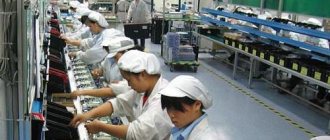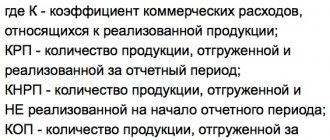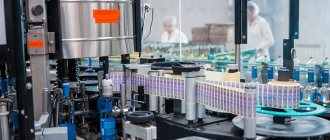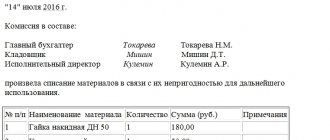What is an estimate of production volumes?
The main tasks for assessing production volumes and rates of product sales are:
- Assessment of the movement of key indicators of the volume of products produced, its quality and constituent elements;
- Identification of factors influencing the dynamics of movement of these indicators;
- Determining the availability of reserve opportunities to increase the growth rate of production and sales of manufactured products;
- Planning a set of measures for the rational use of internal reserves of a manufacturing company.
Estimation of production volume can be characterized by a set of indicators. These are natural, conditionally natural, indicators of cost and labor costs. The main indicators of production volume are gross and marketable products. Gross – consists of the total number of products manufactured and work performed. It includes indicators of work in progress and on-farm turnover. Gross product is expressed at current prices excluding VAT (value added tax). In modern conditions, in cases where there is no on-farm turnover and remains of unfinished production, the gross product coincides with the commodity product.
The production features of a number of companies dictate the choice of algorithm of actions, stages, methods and calculations for assessing production volumes and sales of products.
Assessing production and sales volumes consists of analyzing the competitiveness of an enterprise in the market and its capabilities to harmoniously and adequately respond to any changes in market conditions, competently managing production resources.
This assessment is carried out based on the following indicators:
- Production volume and characteristics of products;
- Compliance with contractual obligations and product sales volumes;
- The quality of products and their functional level;
- Reserves for growth in production volumes, reserves to ensure growth in production volumes and sales of products;
- Insurance of financial risks and stability of break-even production.
The main sources for analyzing production volumes and sales of products can be statistical reporting data and financial accounting documents.
There are four stages in assessing production volumes and organizing production:
- Assessment of the growth of gross product output, marketable products and their relationship with the volume of products sold.
- Estimation of the volume of production programs based on production volume by product groups.
- Study of product structure and the impact of structural changes on the implementation of production plans.
- Analysis of the parameters of the break-even state and determination of the margin of financial stability of the enterprise.
Read the article: Marketing market analysis: types, stages, methods
How to assess the dynamics of production volumes and product sales
The objects of assessment are three types of products:
- Gross
;
- Commodity
;
- Realized.
In the structure of this analysis, the main role is played by the assessment of absolute (indicators - in rubles) and relative (indicators - in %) changes in the volume of manufactured products over a certain period of time (for example, per month). The dynamics of production volumes and product sales for the same period last year or as of the beginning of the current year are assessed.
When assessing production and sales volumes, the following indicators can be used: natural (in units, pieces, tons, liters, meters, etc.), conventionally natural (the number of conventional units of measure and weight), cost (volume of production in monetary equivalent) . The most preferable is the cost indicator.
Cost indicators for assessing the volume of production must meet compliance requirements to be able to compare them with other factors. For effective data comparison in an inflationary market, price change (cost factor) is one of the most important conditions for data comparison.
In the international economic practice of estimating production volumes, there is IASC standard No. 15 “Information characterizing the impact of price changes,” which reflects two key concepts. The first follows from the methodology for estimating in monetary units the identical purchasing value of objects subject to accounting. This concept is based on the aggregate inflation index of the national currency.
The second is presented under the heading “Methods of revaluation of accounting objects to current value.” This technology focuses on the use of personal price indices for a product or a specific product group. The following techniques can be used within this methodology:
- Recalculation of production and sales volumes for a limited list of products for the reporting year at prices of similar products of the base period;
- Adjustments to the aggregate index of price changes (Jc) for groups of similar goods, works, services provided or for a direction (industry) as a whole:
VVP1 – production of products in physical terms for the reporting period;
VVP0 – product in the base period in physical terms;
P0 is the price set per unit of product in the base period.
Consequently, the actual volume of output (comparable to the base volume) is calculated using the formula:
VP1 – expression of the cost of the volume of output.
In the case when the methods described above are used in assessing production and sales volumes, the impact of price changes on a certain product or group of products is virtually reduced to zero.
Read the article: Parallel import: problems and prospects
Assessment of production volume indicators in standard hours
When estimating production volume, you can make a mistake if you use only the cost indicator. This is because this assessment in terms of value is strongly influenced by the process of changing the structure of output and purchasing prices for raw materials.
Changes in the structure of manufactured products depend on a number of reasons:
- Lack of technological equipment;
- Failures and interruptions in the organization of logistics;
- Increasing the cost of manufactured goods.
When the structure of manufactured products fluctuates, cost indicators do not in any way characterize labor costs. This is due to the fact that the cost of a product includes the totality of real labor and material costs for its production. This combination has its own indicators in different types of products. Therefore, when assessing production and sales volumes, labor-intensive, material-intensive and capital-intensive production are distinguished. Since a direct relationship cannot be established between labor costs and prices for the created goods, changes in the structure of production have a serious impact on the assessment of production volumes in terms of their value.
This fact leads to the need to have more effective tools for assessing production volumes and sales of products at a particular enterprise. The analysis algorithm includes an assessment in standard hours and the establishment of standard wages.
Estimating the volume of products produced in advance involves determining the indicator of the quantity of the product that is produced through the own efforts of the business entity, its labor productivity, the maintenance of funds, the amount of material resources expended, and the percentage return on the produced goods.
To estimate the volume of manufactured products in terms of standards fulfilled for a specified period of time (standard hours), it is necessary to multiply the quantity of planned products by type by the actual quantity of product produced. The resulting total number of standard hours spent on creating a separate product is summed up and thus the total volume of manufactured products is obtained in standard hours. Next, calculations are made of the growth rate of production volumes in standard hours and the implementation of the plan is determined.
All required data, including labor costs in standard hours per unit of product produced, can be calculated using Form No. P-1 (for product output) from the business plan or from operational and technical accounting materials.
Estimation of production volumes does not reflect the complexity of the technological process, as well as the quality and volume of labor expended, which is determined in standard hours. This is its key drawback.
The assessment of production volumes in standard wages is determined based on the actual quantity of products produced according to the plan, multiplied by the wage rate per unit of product produced. After summing up the costs of standard wages for all products, the planned and implemented production volumes, expressed in standard wages, are determined.
Read the article: Countertrade and its features
Products in the quality management system
From the point of view of the quality management system, products are the result of a process as a set of interrelated or interacting activities (GOST R ISO 9000-2008).
The quality management system distinguishes four general product categories:
- services (for example, transportation);
- software (for example, a computer program, a dictionary);
- technical means (for example, engine unit);
- recyclable materials (for example, lubricant).
Products may consist of items that fall into different general product categories. For example, a product such as a car includes technical means (engine, transmission, tires and many other technical elements), materials that are processed (gasoline, lubricant, coolant and others), software (software engine control, driver's instructions) and service (explanation of how to drive a car, after-sales (warranty) service)
Cost estimates of production volumes
Estimating the volume of production and sales of products in monetary terms is the most plausible in determining the production and economic activities of an organization. This method is the most realistic in assessing the volume of production of goods that are diverse in their quality indicators and assortment.
Assessment of all volumes of production and sales of an enterprise's products according to cost criteria makes it possible to determine the volume of production in production associations and industries, in general for industry and the national economy on a national scale. This assessment makes it possible to monitor the dynamic growth of this indicator over time, calculate and analyze labor productivity, profit volume, degree of profitability and other parameters characterizing the operation of the enterprise for a specified period.
When determining the volume of cost of production and sales of products, the volume of products produced and the volume of their sales in monetary terms are taken into account. At the same time, a distinction is made between the cost of total (gross), nominal (commodity) and sold products. In addition, in determining production volumes at enterprises, the newly created value that was formed as a result of the labor activities of the enterprise’s employees is assessed. Such an assessment includes the following two indicators: the net production indicator and the value added indicator.
There are differences in the assessment of production cost volumes between these parameters. The “Net Product” indicator determines the amount of additional value that the enterprise produced over a specified period of time. The indicator “Added value” is the amount of additional produced and realized value in a certain period. The first indicator can estimate the volume of production and sales prices in constant prices, in which the volume of gross output is estimated. The “Added value” indicator evaluates products in prices for which the products were actually sold in a specified period of time.
Gross value
- this is the monetary equivalent of all products sold by an enterprise, association or industry for a certain calendar period.
In assessing production cost volumes, the enterprise's gross product takes into account:
- The total cost of all products produced according to technical specifications and standards for a specified period of time, combined with the cost that was spent on the needs of the enterprise itself (for example, on energy carriers and energy resources);
- Cost of produced semi-finished products;
- The cost of production services provided by the enterprise;
- Changes in work in progress balances.
Analysis of the volume of the cost of production of gross output, as a rule, is carried out on the basis of prices that are considered to be constant over a long calendar period. However, the possibility of performing this analysis in current prices for product sales is not excluded.
To assess the total volume and dynamics of production during the calendar period under study, the value of gross output is used.
Gross production volume is calculated using the formula: VP = TP + (Nk. g – Nn. g),
where VP is gross output;
TP – commercial products;
Nn. g, Nk. d – balances of work in progress at the beginning and end of the year.
Commodity value
is the cost of products produced by an enterprise that meet the requirements of technical specifications and standards and are intended for sale on the market. The assessment of product sales volumes includes: the cost of all products manufactured by the enterprise, except for the part that was used by the organization itself, and the cost of production commodity services that were provided by the enterprise.
Fluctuations in indicators of work in progress balances are not taken into account by commercial products.
The assessment of production volumes based on the cost of marketable products is organized taking into account the current level of market prices for these products in a specified period of time.
Cost of products sold
for third parties at prices set by the sales market. These products include industrial services provided by the enterprise.
The volume of planned products sold is calculated using the formula : RP = He + TP – Ok
,
where RP – sold products;
TP – commercial products;
He, Ok - the balance of unsold products at the beginning and end of the period.
Estimation of the cost of production volumes based on the value of newly created products (net products) is determined as follows. The value of gross output minus material costs and depreciation charges or as the total wages that were spent on the production of products, plus the expected profit from the results of its sales.
One of the possible formulas: PE = VP – MZ – JSC,
where PP is net production;
VP – gross output;
MZ – material costs;
JSC – depreciation charges.
A certain amount of goods and services produced and increased by an enterprise constitute added value.
All of the above indicators for assessing the cost, volumes of products produced and sold have different contents and ways of use. For example, the indicator of the value of gross product allows you to compare levels of production in different periods of time and makes it possible to determine the direction of growth in production volumes. Using the figure characterizing the size of the gross product, you can most accurately track the state of staff productivity.
The estimated cost of manufactured goods illustrates the volume produced for sale. When parameters such as the volume of gross and marketable output in assessing production volumes demonstrate the production results of an enterprise, then the indicator of goods sold additionally evaluates the economic activities of the organization.
In assessing the volume of production and sales of products, the volumes and cost of the product sold in certain time periods may differ significantly from the same parameters of commercial products. In case of weak demand or as a result of unsatisfactory sales of goods, the volumes of products sold will be significantly less than the volumes of the product produced. In contrast to this, it happens that when assessing production volumes, it is clearly visible that the volumes of products sold, even if there are balances in the warehouse, significantly exceed production volumes for a certain period of time. This phenomenon can be characterized as the dynamics of active sales.
There are also differences in the selling prices of goods. When setting the cost of products, you should use average prices, and when analyzing volumes of sold products, you should use the actual prices of a batch of goods in the time periods under study.
Read the article: Product market analysis is the first step to an effective marketing strategy
I. For the production and sale of products sold at wholesale prices, types of products in physical terms, products for export 3) since 1972 together [p.136] PRODUCT YIELD RATIO - the ratio of the amount of products produced in physical terms to the total consumption of raw materials for its production.
For example, the output from 1 m2 of wood, 1 ton of metal. [p.141] In oil production, one product is obtained (oil and gas in oil equivalent). Therefore, when analyzing labor productivity, preference should be given to the natural expression of production. [p.83]
In well drilling, the calculation of labor productivity in value terms is made according to the estimated cost-volume of work (without deduction of return), and in physical terms - according to the number of meters drilled. Since the estimated cost of wells is decreasing from year to year as a result of improvements in drilling methods, which cannot but affect the growth of labor productivity, the most rational must be recognized as the natural expression of production, i.e. in meters of penetration. [p.83]
Availability of fixed assets 170 Available production equipment 191 Turnover tax 53 Product in kind 47 [p.313]
The natural expression of products for determining capital productivity has another drawback - it does not reflect the quality of the product. Meanwhile, the same quantity, but different quality, characterizes the unequal volume of products. When expressing volume in value, the quality of the product is taken into account more fully. [p.179]
In the workshop of a chemical enterprise, two types of products are produced, the production program for which is, respectively, AG = 45 thousand tons per year and X2 = 80 thousand tons per year in physical terms. Products are produced simultaneously on different equipment, and only the main production workers are assigned. The rest of the PPP workers are common to both sites. The labor costs of auxiliary workers, engineers, office workers and junior service personnel when determining labor intensity standards are distributed in proportion to the labor costs of the main production workers. It is required to draw up a plan for labor and wages, taking into account the need to separately calculate the cost of each type of product when solving a problem (cost plan), also included in the subsystem of technical and economic planning. [p.107]
Depending on the property inherent in all units of production, chosen for calculating the conversion factors, we can talk about expressing the total volume of production or work in conditional natural, conditional labor or s.-l. other conventional units. To express products in conventional natural units, they proceed from the ratio of k.-n. the main consumer property inherent in all types of these products, bearing in mind the possibility of their use in the consumption process. Examples are the conversion of tractors into conventional 15-horsepower units, slate into conventional tiles, canned food into conventional jars, soap into conventional 40% fatty acid content, etc. Conversion into conventional natural units can be made within homogeneous species products that have the same consumer purpose. M. u. e. is in this case a complement to the natural expression of industrial products. [p.451]
NATURAL EXPRESSION OF INDUSTRIAL PRODUCTS [p.13]
NATURAL EXPRESSION OF INDUSTRIAL PRODUCTS - calculation of products in physical terms. measures (weight, length, volume, etc.), which makes it possible to determine its volume as a set of more or less homogeneous material goods (use values). N.v. p.p. is widely used in planning and statistics. For example, according to the seven-year plan, the production of cast iron (according to updated data) is planned to increase in 1965 to 72-73 million sh., steel - to 95-97 million tons [p.13]
At every prom. In the enterprise and in individual workshops, planning and accounting of products are carried out in physical terms, which serves as the basis for determining the implementation of the assortment plan. For some types of products, the natural expression provides for several units of measurement (for example, fabrics are measured in linear and square meters, steam boilers - in pieces and square meters of heating surface, etc.). The volume of production of similar products that have the same basic consumer property, although not to the same extent, is often calculated in units of k.-n. one product accepted as conditional, i.e. in conventional natural units (see Products in conventional terms). This provides a clearer idea of the volume of production as a mass of use values. The natural expression of products also serves as the basis for establishing the cost indicators of its volume. [p.14]
The features of the gross output indicator make it advisable, along with general industrial production. p. by p. t., calculated on the basis of the value expression of products, calculate, where possible, the implementation of the labor productivity plan on the basis of the natural or conditional natural expression of products. So, in coal mines and open-pit mines the actual data is compared. and planned indicators of average coal production (in tons) per worker in spinning production - [p.264]
In physical terms, communication products are measured by the volume of exchange - the total number of items of a certain type accepted by communication enterprises from manufacturing industries, as well as the number of units of communication devices (CDs) leased to manufacturing industries. [p.240]
Measuring labor productivity in physical terms (in million m3, thousand t-km) is to determine the amount of work performed (products produced) per unit of time. The natural meter is the most reliable and visual; it is used to compare the level of labor productivity of teams, units and individual workers when performing similar work or producing identical products. It is difficult to compare labor productivity in different types of work using this meter. [p.195]
The cost of production of socialist production enterprises and associations refers to the costs of production and sales of products expressed in monetary terms. The ratio of these costs to the volume of products produced in physical terms characterizes the cost per unit of production. [p.237]
Depending on the characteristics of a given enterprise, quality indicators such as saving material resources, increasing capital productivity and shift ratio, level of profitability, reducing costs, and increasing production in physical terms can be used as capital-forming indicators. [p.295]
Production of main types of products in physical terms, including products for export. [p.81]
An independent subsection includes indicators of the technical and economic level of production and output, divided into two groups: general and industry-specific. The latter should characterize qualitative changes in manufactured products, for example, the average nutrient content in mineral fertilizers, the level of technical base and use of equipment, for example, productivity, average unit power, volume of production using advanced technology, equipment, for example, in installations of large unit capacity, labor productivity in natural terms in terms of material intensity of production, etc. [p.132]
When an enterprise or workshop produces dissimilar products, production capacity cannot be shown in total, since such products are usually incommensurable in their consumer properties and other characteristics. In these cases, production capacity in physical or conditionally natural terms is calculated and shown for each type of product separately. [p.157]
When drawing up a production program, the nomenclature and range of commercial products produced by the association must be clarified and detailed. On the basis of this, planned targets are established in physical terms for production units and their divisions in the following sequence: producing units, processing units, and preparatory units. [p.176]
Enterprises, based on the production plan and business contracts, establish plans for the supply of products in an assortment for specific consumers, linked to the volume of product sales in physical terms. [p.177]
The directive indicators of this section of the plan are the growth of net production (normative), and in certain industries - commercial products at comparable prices, the output of the most important types of products (including for export) in physical terms, and the growth of production of products of the highest quality category. [p.177]
The volume of production in physical terms is usually shown in plans for gross output and only in some cases - for commodity output. [p.177]
The production plan in value terms, drawn up on the basis of the production plan in physical terms, is presented in the form of the following indicators: the volume of net (normative), commercial, gross and sold products. [p.178]
Optimization based on the criterion of maximum production volume. This problem has two varieties depending on the units of measurement of production volume. The first is maximizing the volume of production in physical terms, which means simultaneously calculating production capacity based on the optimal assortment. [p.190]
Product output in physical terms, tons [p.206]
The second indicator of this group has changed significantly. Instead of producing the most important types of products in physical terms [p.51]
The production and sales plan is the main section of the TPFP, affecting the indicators of all other sections. It includes a production program in physical terms using a more detailed nomenclature than in the five-year plan, and in value terms, calculations of production capacity and the level of its use. To assess the fulfillment of obligations for the supply of products (under contracts and purchase orders), a special indicator is approved - the volume of product sales. [p.84]
Production capacity must be measured and taken into account, like products, in material form, in kind, which makes it possible to directly link the specific needs of society with the specific capabilities of production to satisfy them. Measurements of the production capacity of equipment and any production links of an enterprise are physical units of measurement of manufactured products (units of mass, volume, piece, etc.). But the use of certain production capacity meters is associated not only with the nature of the product, but also with the characteristics of different chemical production facilities, different facilities, and the degree of their specialization. Measuring the production capacity of equipment specialized in producing one product is not difficult. For example, the production capacity of a pyrite roasting furnace or for burning sulfur is measured in cubic meters of sulfur dioxide, the production capacity of a chamber for aging superphosphate is measured in tons of superphosphate, etc. However, many types of equipment can produce several types of homogeneous products (for example, varnish boilers and paint grinding machines in paint and varnish production, injection molding machines and presses in the production of plastic products, etc.), differing in composition, labor intensity, manufacturing mode, dimensions, etc. Despite the fact that the production capacity of such units can be calculated for individual varieties products (based on the distribution of the time fund of this equipment between products), there is a need to calculate it also unambiguously, which can be achieved by expressing it in conditionally [p.154]
The recalculation of the production capacity of a machine or apparatus, calculated in physical terms, into conventional units (and vice versa) is carried out on the basis of conversion factors characterizing the relationship of each type of product with the product taken as a unit according to the selected attribute (conventional product). As signs for determining the ratios of different types of products, those that determine differences in the productivity of equipment for production or labor intensity (machine intensity), or some of the parameters that determine them (weight of a unit of product, its dimensions, speed of processes, etc.) should be taken. ). The quantitative characteristic of a characteristic (according to the accepted measure of its evaluation) for a conditional product is taken as one. Conversion factors for converting all other types of products into conventional units are calculated as the ratio of the assessment of the selected attribute for any (of the considered) product to the assessment of the attribute for the conventional product (or vice versa). [p.155]
To measure products in physical terms in the chemical industry, two types of units are used: 1) with an indication of the content of the main substance - according to GOST or TU or according to a conditional standard (when the production of several varieties and brands of products is provided), for example, the conversion of HgS to monohydrate, and 2) without indication of the content of useful substances (SA, resin, plastic, etc.). [p.178]
The volume of standard net production is determined during planning (and in the report) by multiplying the volume of products of each type in physical terms by a stable standard of net production. [p.179]
The supply plan for chemical products is a set of planning and calculation documents that establish the range of chemical products sold and their quantity, quality requirements and delivery times to consumers. It is developed on the basis of contracts and orders for the supply of specific chemical products to industrial enterprises, supply chain and trade organizations (in kind) and is the main document according to which the enterprise fulfills its obligations to consumers. [p.229]
According to the resolution of the Central Committee of the CPSU and the Council of Ministers of the USSR dated June 30, 1981, the norm is a directive indicator of the consumption of material resources. This means that for the most important types of materials, the consumption rate per unit of product or work is established in five-year and annual plans in physical terms. Individual consumption rates are centrally introduced for the most material-intensive products. The range of material resources for which centralized targets are set for an average reduction in consumption rates has been significantly expanded. At the same time, targets for the average reduction in consumption rates of raw materials, fuel, thermal and electrical energy in production are determined for the planned period of the year in economic and social development plans on an accrual basis as a percentage of the base year. This will make it possible to develop and implement measures for the economical use of raw materials and fuel and energy resources evenly over a five-year period, rather than postponing the implementation of the savings regime to the last year of the five-year plan. [p.180]
Assessment of factors influencing production volume
Estimating the volume of product sales at an enterprise consists of the sum of many different factors. All indicators that affect the volume of production and sales of products can be grouped as follows:
1) Factors that demonstrate the organization’s provision of fixed capital, such as monetary resources and the frequency of their use;
2) Factors that demonstrate the provision of the organization with material resources (raw materials, materials, energy resources, etc.), as well as the use of these material resources;
3) Factors that provide the organization with personnel (human resources) and their use in production;
4) Factors that are interconnected with the introduction of innovative techniques at the enterprise, updating technical equipment and producing new products;
5) Factors that interact with market movements and consumer reactions;
6) Factors related to market performance:
- product prices;
- competitive quality of goods;
- market saturation with similar products;
- consumer purchasing power;
- degree of consumer confidence in the product;
- characterization of the mood of consumers of the product;
- determination of target market directions;
- positioning the functional advantages of the product on the market;
- characteristics of professional training of marketing structures.
When assessing changes in the volume of sales of products, attention is paid to such points as the production and release of goods for the period subject to reporting, warehouse balances of manufactured products formed at the deadlines of the period of reporting activities.
The estimate of changes in sales volume is determined by the comparison method. In this case, changes in warehouse balances of finished products and shipped goods at the last date of the calendar period have a negative impact on the change in the indicators themselves.
During the development and implementation of the production program and at the time of signing contracts, it is important to pay attention to the consequences of changes in the economic conditions of contractual relations (calendar deadlines, volumes of product supply, prevailing prices for the cost of raw materials and manufactured products). A significant role is played by the influence of fluctuations in cost indicators in comparison with given standards on the total profit planned for the end of the period under study.
This problem when assessing production volumes and sales of products is solved through factor analysis
production program under certain contracts for the supply of products, taking into account the technology of its production, as well as the increase or decrease in costs for certain types of products. This analysis is based on how costs and profits are related to each other. At the same time, it is based on calculations of the impact of the number of sales and expenses on the profit margin.
Analyzing the volume of production and sales of products at a certain level of expenses, it is necessary to solve another problem: focusing on the planned revenue, calculate the required volume of sales to obtain a given profit and the volume of products produced to extract it. The dynamics of how the levels of fixed and variable costs, the volume of production and sales of products, and the cost of materials for each individual contract affect the overall profit can be calculated using the formula:
P = K × C – (MZ + Neg) – Rup – Mon,
Where:
P – profit;
K – natural value of the number of products of the same name;
P – unit price;
МЗ – material costs equivalent to the cost of certain types of products;
Otr – wage costs;
Rp – semi-fixed expenses;
Mon – profit of remaining unsold products.
This formula allows you to see how certain factors influence possible profits:
- Decreased product quality, decreased demand for the product, disruption of delivery stages and, as a result, refusal of the purchasing party’s agreements;
- Changes in planned production volumes at the initiative of the purchasing party;
- Changes in technology due to replacement of production materials, including due to delays or disruptions in their supplies;
- Changes in prices for materials, which leads to changes in prices for products.
From all of the above it follows that, having determined the key factors for assessing changes in production volumes and sales of products of an enterprise based on a factor model, it is possible to predict the expected profit from further sales of goods and minimize the influence of negative factors that inhibit the growth of sales volumes and product sales.
Read the article: Analysis of the competitive environment: main stages and methods
The concept of finished products and their evaluation
The final product of the enterprise's production process is the finished product. Products are considered finished only if they are fully equipped and comply with technical specifications that are approved in the prescribed manner; delivered to the finished product warehouse and equipped with a certificate or other documents that certify the quality of the finished product. Finished products make up the bulk of the enterprise's output. In addition, finished products may include parts, assemblies and semi-finished products, if they are sent to customers as spare parts or components; semi-finished products produced in-house, work performed and services of an industrial nature are also supplied. Works of an industrial nature are considered to be the services of auxiliary workshops for the supply of steam, water, electricity, compressed air, road transportation and other services provided by third-party enterprises and organizations, for their own non-industrial farms or for their own capital construction.
Finished products are mainly intended for external sales, but some of them can be used within their own enterprises.
Products that have not undergone all the required technological processes, processing operations, as well as products that have not passed testing and technical acceptance are not included in the volume of finished products and are subject to accounting as work in progress.
Enterprises manufacture products in accordance with planned targets for assortment, quantity and quality. At the same time, much attention is paid to increasing its volume, expanding the range and improving quality.
Currently, the sale of products under supply contracts is becoming important as the most important economic indicator of work, which determines the efficiency and feasibility of the economic activities of enterprises.
The volume of product sales, taking into account the fulfillment of contractual deliveries, determines the amount of profit of the enterprise - one of the most important indicators of its activity.











